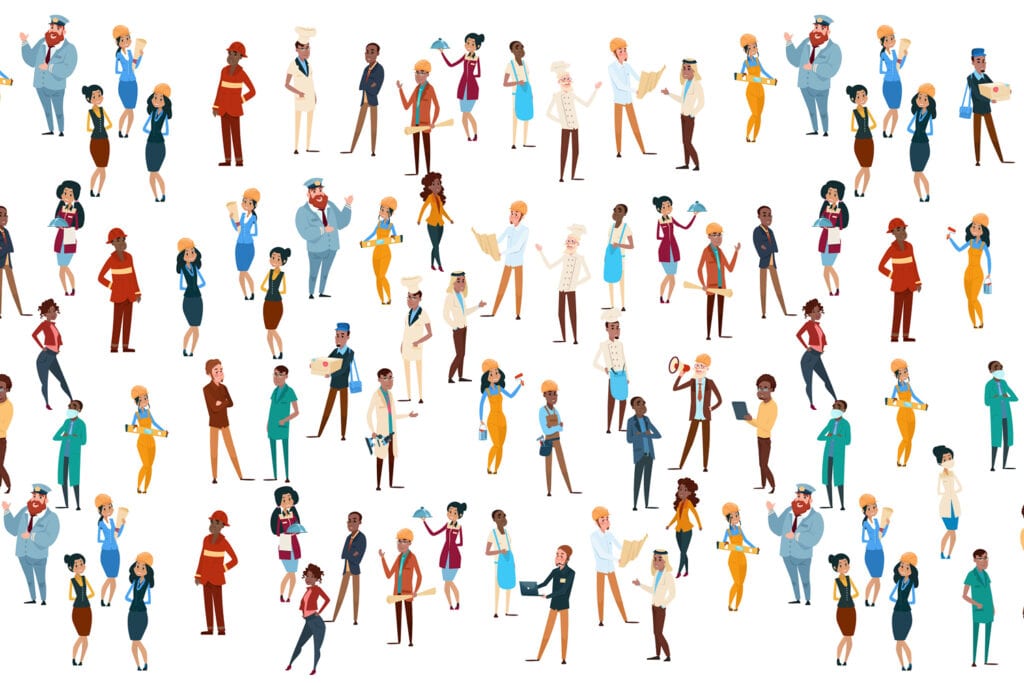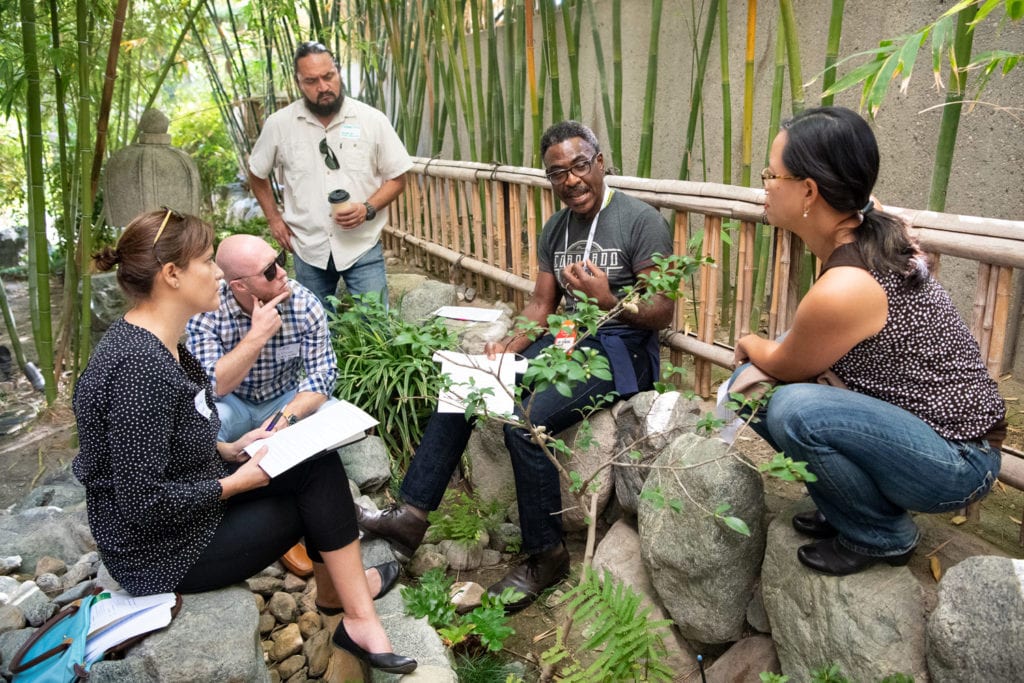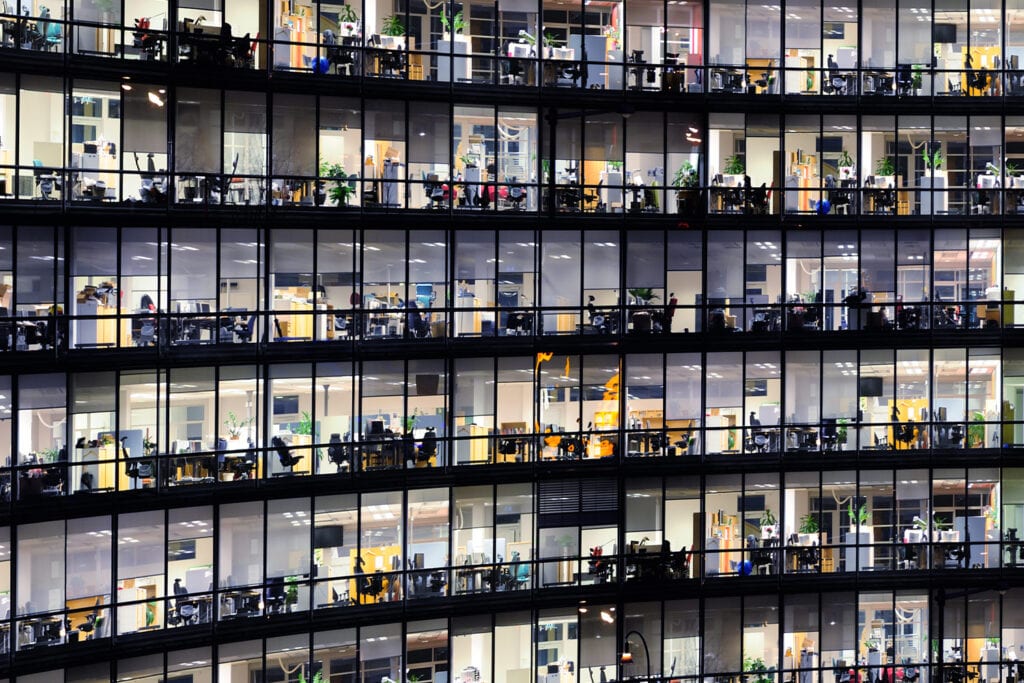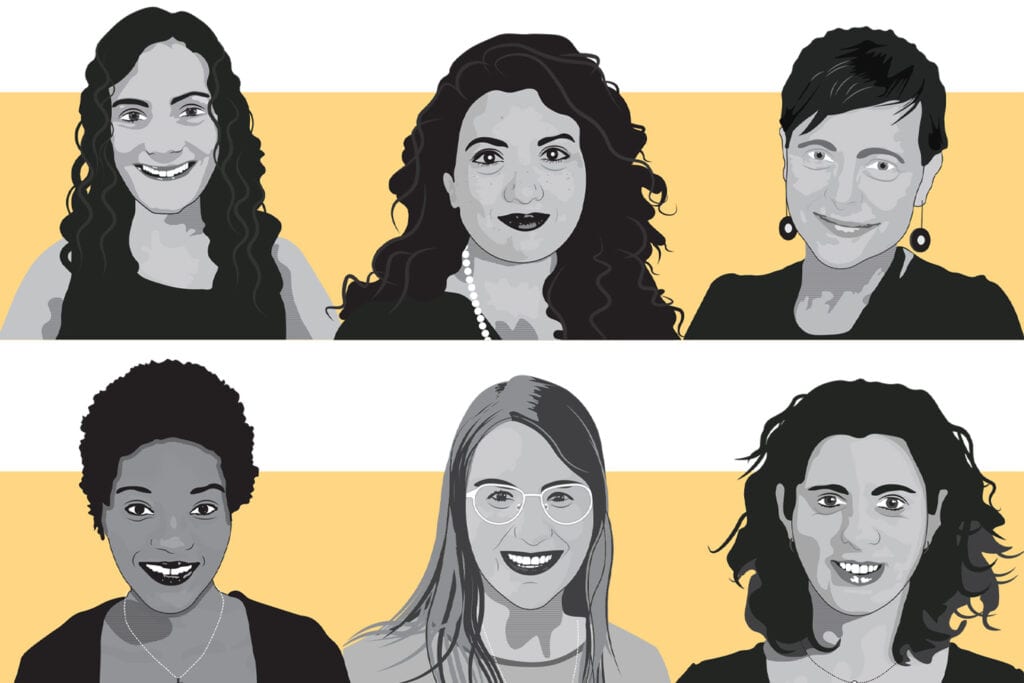Q&A with the US Diversity and Inclusion Forum
As we wrapped up 2020, our United States Diversity and Inclusion Forum (DIF) co-leaders – Daniel Garcia, Kathleen Hetrick, Louisa McCambridge, Manuel (Mel) Chafart and Mariel Rosenberg – reflected on their successes over the past year and how they see Buro Happold and the AEC industry moving forward in the years to come.

Our Diversity and Inclusion Forum (DIF) is committed to cultivating a diverse and inclusive environment at Buro Happold. To this end, the DIF committee will plan events, provide opportunities for networking, education and outreach, as well as recommend evidence-based policies that lift up under-represented voices. Our objectives are to promote the diversity inherent in our business and encourage inclusive practices that foster a sense of belonging in the workplace.
The responses have been edited for clarity and length by moderator Katelyn Sinon.
Q. What does the diversity and inclusion forum mean to you?
Mel: The diversity and inclusion forum is first and foremost, a forum. We were aiming to create a space where people can voice how they’re feeling – sometimes that leads to events such as career development panels, book clubs, pod clubs, movie nights or sometimes it leads to conversations about deep-rooted concerns that people can listen to and then hopefully solve.
Louisa: It is, in my opinion, first and foremost, a safe space for people in the BH community to bring their opinions and their thoughts and act as a place for everyone to have constructive conversations that can hopefully strengthen our community as a whole and make working at BH a better place overall. Because honestly, we all want where we spend 40 hours a week to be the best place possible.
Mariel: I think DIF is really unique in that it’s a place where anyone in BH can come – from the newest hire to the most senior partner – and have their voice heard equally and actually have an impact on the culture of the organization.
Daniel: To me DIF is about people. We spend so much of our work wrapped in numbers and sketches, that it’s too easy to lose sight of the human beings next to us and the human beings we’re working alongside. Our own experience will never be the only experience in the room. DIF is an opportunity to get to know our colleagues, our industry, our firm, and determine as a collective what type of culture and what type of community we want to participate in.
Q. What do you think that your fellow colleagues and even external people should know about your work in DIF?
Louisa: That is why I think creating a diverse and inclusive and equitable workplace is so important, because speaking from personal experience, I feel like I really care about the people around me and the people around me really care about me. Building such a great community is what’s important.
I’d like people to know that at BH, as a community, we don’t just come to work and put our heads down and leave. We are genuinely people that care about the people around us.
Louisa McCambridge, 2020 DIF Leader
Daniel: In many ways, DIF work follows the same problem-solving route as our engineering work. What is our goal? What are the obstacles in the way of that goal? What tools do we have to relieve those obstacles? I’d say it actually challenges the parts of our engineering minds that we might not challenge enough: Who is this goal for? What steps have we taken to consult with those people? Who have we not considered regarding this?
Mel: Let’s talk about diversity and inclusion. We’re trying to promote and celebrate that people with different backgrounds (Race, gender, sexual preference, age, religion, immigration status) are working together. Diversity is good for a company culture. Diversity is good for creativity. It’s good for innovation. It’s good for growth.
But the harder step to accomplish is inclusion.
When we have all these different diverse people, are we making sure that everyone feels safe? Are we making sure that everyone is welcome in the space that they’re working in? When you talk about inclusion, you start thinking about implicit biases, and you start thinking about how are people interacting with each other; is it always positive? We’re working to make our workplace better. You want more people around that have different experiences – and you want them to feel safe and happy when they’re here.
Mariel: I’d want people to know that DIF isn’t just the DIF leaders. DIF is everyone who shows up to the meetings or does the work of inclusion throughout their day at BH. Sometimes this work can be hard. It can be tiring, but it’s much less hard and less tiring and way more effective when everybody stands up to share the load and take on a bit of this culture change themselves.
Q. Can you talk about some of the successes of DIF?
Mariel: To me, one of the biggest success of DIF actually happened before I even joined BH. And that was getting the LA office to have two gender neutral bathrooms, which means that people who are non-binary, trans, gender nonconforming, have a place where they can be safe literally using the bathroom in our office – but also that’s a signal that they’re accepted. They’re respected. They are wanted in our office and in our community.
Kathleen Hetrick: When I was interviewing at BH, I saw that and I knew that this would be a place that was more welcoming to the queer community than a lot of other engineering firms. So I think that maybe it seems small, but I think it actually has a huge impact.
Additionally, continuing our amazing relationship with LA Promise Fund has been so rewarding and so many of our staff and engineers have volunteered their time, advice, skills, and relationships through mock interviews, mentoring, and career days. Pivoting to a virtual internship for our two students this summer allowed engineers and staff from offices across the region to get involved and was a great silver lining amongst the pandemic. To date we have contributed over $45,000 in wages to our summer high school interns and all of the students are attending colleges for STEM careers.
Louisa: Something that I genuinely really enjoy is ‘Pod Club.’ It’s similar to a book club, where everyone gets together and listens to a podcast on their own time and then we set 45 minutes aside a week and we come together. One person leads (that changes based on who has a topic they want to discuss) and we talk as a group on the impacts of that podcast on you personally, and how it affects your thoughts on the industry, or be it just community or things like that. So it’s a safe space. It’s for a conversation.
It seems like such a small thing, but I love that so many people in our community are willing to come and share their opinions and spend an hour talking about topics that maybe on the surface aren’t really in your face like bias training, but rather to have a community discussion about a cultural topic.
Daniel: I’d say the successes that have hit home were the impromptu moments we came together as a community. The Book Club meeting that resulted in an hour lunch talking about the gender-equity of stadium restroom design. The peer interviews on International Women in Engineering Day where we learn about the challenges some of our colleagues carried through their career. The listening sessions after the murder of George Floyd where staff came together to grieve and hold each other accountable.
For me the greatest successes were when we took off our engineering goggles and saw each other as human beings, participating in an often-unequitable society.
Daniel Garcia, 2020 DIF Leader
Mel: After the death of George Floyd and countless others at the hands of the police, we, as a DIF community, rallied together and got some powerful, concrete things done in our offices. We created a working group to address issues we saw in the company, and there are two things that came out of it that I’m most proud of.
First, the listening sessions. We had over 170 employees, over the span of a day, come to listen and share with their fellow employees about their experiences. People were very raw, rightfully so. We allowed our employees to be vulnerable, and we supported them during a transformative time in our country’s history. I thought that was one of the most important days in my career at BH.
On top of that, I’m also very proud of the statement that the US region put out. We acknowledged that this isn’t a problem that we can solve overnight. We acknowledged that we’re not doing enough, and we laid out some clear steps about how we’re going to improve our company culture, both internally and externally. That has been our beacon of social progress here at BH.
Mariel: I’d have to agree with Mel. It took dozens of people across every single office to get the company to emphatically say Black lives do matter. Buro Happold as an organization recognized that it had historically fallen short in championing racial justice, but also it is willing to look that in the eye and say, “well, we know we can’t fix it at all, but we can at least do our best to make BH a little safer.” I’ve been really proud that we’ve sustained that effort, and it seems to actually be having impacts.
We’re beginning to change mindsets and we’ve gotten training about “creating a common language” around racism. I think that’s going to be a really important foundation that future leaders will be able to expand upon. Slowly we’ll be able to change the culture. I’m proud that we were able to have that moment. It didn’t just come from the DIF leads. It came from this upswell in emotion from BH. And I think that is what’s going to be able to sustain action.
Q. What do you find to be the greatest challenges for improving diversity and inclusion at Buro Happold?
Mariel: I would say the biggest problem we’ve encountered is that as engineers, our mindset is geared toward quick problem solving. When we identify an issue, we want to be able to write out the formula and fix it. And with diversity and inclusion and equity, you can’t do that. The problems are too systemic, so we really have had to shift our mindsets from quick fixes to changing cultures, which definitely has a longer timeframe.
Louisa: Yeah, I was thinking in the same vein – it’s not black and white, and we love black and white. I think the second problem is the overall time that it takes to do these things. It’s not just like, “Oh, snap my fingers and no one will have bias anymore.” Having an overall BH commitment to reflect on our culture as a company, and then enact changes, is a huge roadblock that we face.
Daniel: I believe Buro Happold is a progressive leader in our industry, and I am proud to say that it’s harder for me to find a colleague that doesn’t believe in changing the status quo for the betterment of marginalized communities. It’s harder when you don’t have that baseline to start at, and I’m grateful we have it.
But intent doesn’t have much value without action. I think the greatest challenge is inertia. I think we all, myself included, can get bogged down with an often-heavy workload, not to mention our own efforts at a healthy work-life balance. I believe everyone wants change to happen but not everyone knows where to start and more so not everyone has the capacity to act.
Tackling DEI initiatives is no small feat, especially when there aren’t obvious metrics of change. It costs time, money, emotional labor, participation at all levels of the firm, and a shared language of the challenges at hand. And in any business, those are heavy boulders to budge up the mountain when the summit isn’t necessarily a dollar figure.

Q. In terms of the engineering field at large, what do you think the greatest challenges are in terms of diversity and inclusion?
Daniel: I think STEM fields are notoriously lacking in diversity and inclusion of any kind, and the AEC industry is no exception. It is a systemic issue, meaning it even doesn’t matter if every person believes the field is open and accepting – it isn’t there yet, and that doesn’t change without working on it.
Outreach for K-12 STEM mentorship means nothing if underfunded schools lack resources to maintain that curriculum. Unlearning unconscious bias in new hire recruiting means nothing if colleges don’t admit a diverse student body. And recruiting a diverse workforce means nothing if the workplace itself isn’t an actively consciously aware, actively anti-racist, actively anti-sexist, or actively anti-ableist culture.
I think that the engineering industry – from the university level all the way through the biggest companies – is still stuck on the idea of who an engineer is and what an engineer looks like.
Mariel Rosenberg, 2020 DIF Leader
Mariel: There are all these barriers to entry to even begin studying engineering. And, you know, it’s mostly men, it’s mostly white men who can afford expensive college tuition.
And once you pass all of those barriers to entry… the question becomes who’s made comfortable enough in those environments to stick at it? Once you finish university, you’ve worked so hard, but are people willing to hire you? If you don’t look like 90% of the other engineers out there, how are they making you feel comfortable at the company so that you stay and don’t burn out? As a whole, that the engineering community really hasn’t grappled with that enough. There’s lots of tokenization, but there has not been a big enough shift in the mindset.
Mel: As engineers, we have the ability to influence the way people go about their daily lives. We also have control over what projects we choose and what goals we have in mind when we work on them. Those aspects require more thought and care, and I don’t think the industry is quite there yet.
We have impacts on racial equity, labor, environmental justice – does every engineer think about these topics before they’re starting their new project? I don’t think so, but I think that needs to change if we want to create a truly diverse, inclusive and equitable environment.
Manuel (Mel) Chafart, 2020 DIF Leader
Daniel: I challenge Buro Happold and every other firm committed to diversity and inclusion work to make it concrete – a budget, a team, a plan. Continually ask what obstacles are in the way and ask, ”what will it take to remove those obstacles?” Prioritize equity right alongside engineering, marketing, HR, or accounting, and don’t let it become just another “we don’t discriminate” proclamation. Keep questioning, keep listening, and keep trying.
Q. So that brings us to our last question which is, what are you most proud of regarding DIF?
Mel: I’m really happy with how connected we’ve become in the U.S. region. I did not know anyone from the L.A. office before this year. The ability for us to connect with other people on very complex and intricate topics has been really awesome. I’ve made some great friends and I’ve learned a lot about myself by doing this. I’ve been happy and lucky to work with the people of DIF.
Louisa: I feel like my proudest moment of being a part of DIF and helping lead DIF is the amount of great conversation we’ve had – as an entire Buro Happold community. I feel proud about being a part of DIF because it’s a way to be a part of the community and give to the community that’s more than just being a structural engineer. It gave a chance to make our stamp as a part of BH. It makes me so proud when you see people show up to have real conversations, and everyone wanting to really make change with everything that’s happened in 2020.
Mariel: I’m proud that this year we’ve really been able to grow the number of people who participate in DIF as well as the number of people who feel like they should or want to participate in DIF. Often times, I think more senior people or people who didn’t self-identify as diverse didn’t think DIF was for them. I’m proud that we’ve been able to expand the definition and include more people in our Diversity and Inclusion Forum.
Kathleen: Taking on Diversity and Equity in our industry and company via a systemic, organizational approach across our entire region, not just a couple of one-offs events or initiatives isolated to a single office.
So many people have contributed to DIF and created such great momentum. It’s not just the younger staff, or just the Partners… there’s representation and action from all levels, including HR, Operations, Marketing. So cool to see it grow.
Kathleen Hetrick, 2020 DIF Leader
Daniel: I’m proud at how far we’ve come. The West Coast DIF was founded, shortly before the start of my career, as a simple grassroots movement by members of the office to address inequities and inclusivity within our firm and within our industry.
Today we have a region-wide U.S. DIF with at least one co-chair per office, frequent meetings with Human Resources, Business Development, and the Chair of the US Regional Board, and active membership participation from all levels of seniority. The work is never done and some days it can feel like running backwards on a treadmill. But the buy-in we have developed across the practice in over a few short years has been incredible, and I’m so excited to see where DIF goes next.
Congratulations to you all. It’s been a successful year for the group.
Over the past year, Buro Happold has invited our communities to share their experiences so we could all listen and learn. We are grateful to our colleagues for their openness, and we are committed to using these insights to guide and shape our company. In the coming months, we’ll be publishing further information about what we are doing at company level – as well as further news about what our colleagues have been exploring at regional level.




